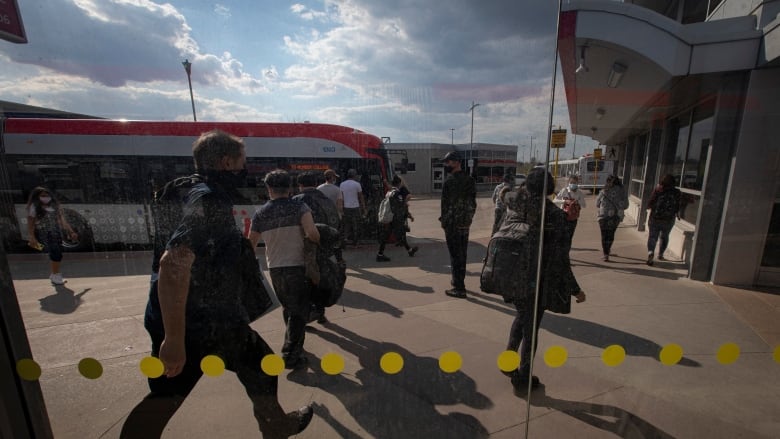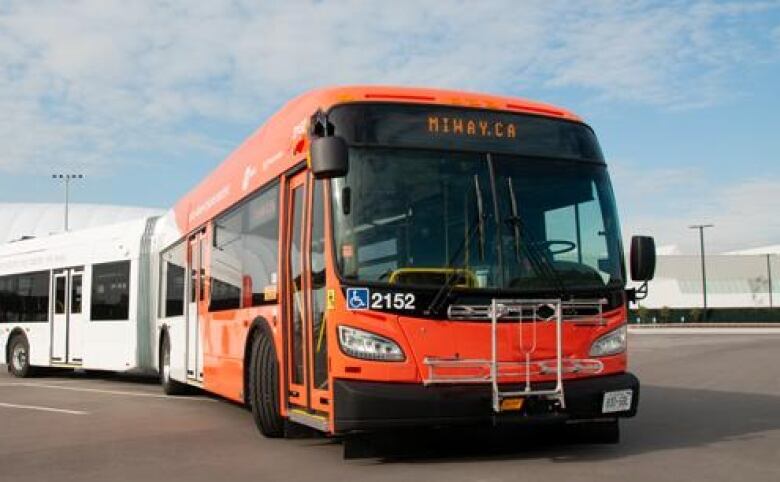Better integrated transit services can't come soon enough for these GTA commuters
TTC taking steps to improve service integration with 905 transit agencies with pilot project

Aria Bakhtiarizadeh's daily commute to Humber College'sEtobicoke campus isa bit like playing hopscotch.
The first-year student gets on a York Region Transit (YRT)bus in Richmond Hill, then hops on a separateYRTorGO Transit bus that takes him to Bramaleaterminal in Brampton. From there, it's on to athird bus, this time operated by Brampton Transit. Some days, he goes part of the way on Toronto's TTC.
In total, it costs him around $6 each way and takes up to four hours per day.
"It's quite a hassle," Bakhtiarizadeh told CBC Toronto in an interview at the campus bus terminal earlier this week.
Bakhtiarizadeh is just oneof the thousands of people taking public transitacross the Greater Toronto Area every day who have to transfer between different systems and pay multiple fares.
While there have been efforts to improve fare and service integration across municipal boundaries over the past several years, transit riders and advocates are calling for fasterprogress ahead of the provincewide local elections on Oct. 24.
Fortress TTC
Mosttransit agenciesin the communities surrounding Toronto in York, Peel, Halton and Durham regions have some degree of fare and service integration.
Riders likeBakhtiarizadehwho start on aYork Region bus and transfer to one in Peel Region operated by Brampton Transit or Mississauga's MiWay, for example, only have to pay one fare. Many 905-area transit providers also share terminalsand theycan pick up and drop off riders outside their municipal boundaries.
For riders connecting to GO Transit from a 905 service, the province has also made those transfers free.

But the lack of integration between these agencies andToronto's service is a major stumbling block.
"The big nut to crack is getting TTC involved, both with regards to some sort of a co-fare with GO and some sort of a co-farewith the 905 agencies," said Peter Miasek,president of advocacy group Transport Action Ontario.
Riders transferring to the TTC have to pay another faresomething that affects approximately8.8 per centof all TTC customers who begin or end their trips in the 905 on a local service or GO Transit, according to TTC data.
Until recently,buses from neighbouring transit agencies bringing passengers into Toronto could only drop passengers off at stops withincity limits, and those headed outbound could only pick passengers up.

Amanpreet Kaurlives in Brampton but works in Etobicoke, forcing her to take Brampton Transit and the TTC.
"Etobicoke and Brampton they are not too far ... so it should not be a difference, especially if theperson is going for work or school and taking two to three transits," Kaur said."There should be one [fare]."
Bakhtiarizadeh said more bus routes, less transferringand integrated fares would all make his life easier.
"I [wouldn't] have to waste time getting around stations, getting off buses, getting on separate buses," he said. "It would also save money in the long run."
TTC pilot project
Better integration among regional transit agencies in Ontario has been in the works for decades. The Presto fare card is but oneexample.
Then-premier Kathleen Wynne and Mayor John Tory agreed in 2017 to reduce fares for transfers between GOTransit and the TTCby$1.50, but the Ford government let that discount expire.
Miasek said part of the reason for the lack of integration is that it's expensive.
"Every time someone travels across a boundary and doesn't pay a full double fare, one of the transit agencies loses money," he said. "Transit agencies are careful not to lose revenue."
WithTTC ridership, and therefore revenue, yet to fully recover from the pandemic slump, and the City of Toronto facing an $857-million shortfall,thatmoney has to come from the province, Miasek said.

There has been some movementrecently.
In February, the TTC's board approved aplan that will focus on integrating cross-border service with 905 agencies first, while maintaining the existing fare structure until a long-term solution is developed.
The first phase will see a pilot project allowing YRT and MiWay to pick upand drop off passengers within Toronto proper on BurnhamthorpeRoad and the northern part of Dufferin Street. The project will eventually scale up to all 24 cross-border routes.
The TTC said the plan willcut costs, increase bus frequency and allow it to redeploy buses to other areas of the city. According toTTC staff estimates using pre-pandemic ridership data, about sevenmillion out of 34 million annual cross-border trips would use a 905 transit service instead of the TTC because it would be more convenient.
"The plan will bring the same level of cross-boundary cooperation to routes operating into Toronto as already exists on routes operating between 905 agencies," the report said.
Despite those benefits, the plandoesn't have the support of the union representing TTC workers.
ATU Local 113 said itwould "threaten the integrity" of Toronto's transit system and "provide the TTC with a convenient excuse to cut TTC routes and outsource service to other transit agencies."
Province supportive of integration
The Ontario governmentis also chairing a provincial-municipal table on fare andservice integration.
In a statement, the Ministry of Transportation said it continuesto work to advance those goals across southern Ontario and the GO Transit network, addingthat the province recently amended the City of Toronto Act so the TTC's cross-border pilot projectcan go ahead.
"Better integrated cross-boundary travel and transfers will make transit more affordable and simplify the rider experience," the statement said.
When passing its plan, the TTCboard also voted to encourage the province to pay the costs incurred by the 905-area transit agencies to implement the service integration, although the ministry told CBC it hadn't yet received the TTC's request.












_(720p).jpg)


 OFFICIAL HD MUSIC VIDEO.jpg)
.jpg)



























































































